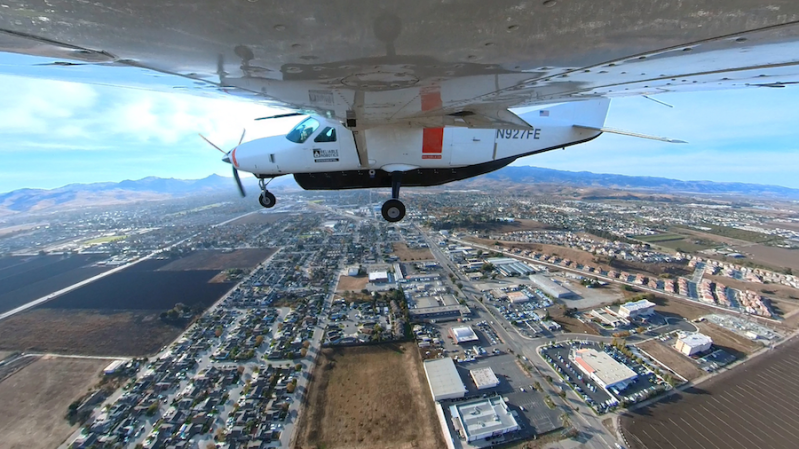Reliable Robotics has been working on Unmanned Aircraft Systems (UAS) since its founding in 2017, with a number of demonstrations for the FAA so far as it works towards getting the technology licensed. Most recently, it flew an unmanned Cessna 208B Grand Caravan with a pilot in a ground-based control center. This comes a few years after the company flew a Cessna Skyhawk 172 in a similar manner, demonstrating the functionality of its systems in a fairly small airplane.
Because the pilot is not in the cockpit, the aircraft needs to be equipped with not only the remote controls and camera systems, but also with automation to handle taxiing, take-off, and landings, which is demonstrated in the in-cockpit video provided by Reliable Robotics (also embedded below). Another large part of the automation is dealing with loss of remote control signal (LC2L). Initially this system will be offered only as a retrofit kit for the 9-13 seater, single-prop Cessna 208B, but Reliable Robotics claims that the system is aircraft-agnostic.
Reliable Robotics is focused on remotely piloted cargo flights, as it would save pilots from the stress of constantly traveling and hectic schedules. In addition, the potential loss of a cargo plane would be far less dramatic than an aircraft carrying passengers. That doesn’t mean passenger airplanes won’t eventually use a remote control system like this, but the certification process for something on the order of even a twin turbo-prop Dash 8 passenger plane is likely to be much more involved.

















I had the pleasure of seeing an earlier version of this, and had hands on the actual flight hardware.
I will dispute the quoted article, which claims “Last month’s successful flight of a Cessna 208B Caravan with no one on board was a first for aviation.”
Maybe true specifically for a ‘208, but it was done 50 years ago with F-86 Sabre jets.
Proof of concept demo video, 1973: https://www.youtube.com/watch?v=iWwV6WSdDg4
Commercial production, in Canada, later that decade: http://yocumusa.com/sweetrose/duncan/flightsystems.htm
It’s done routinely for tomahawks…
Tomahawk, the cruise missile? Not generally a remotely-piloted vehicle. You mean the Predator or Reaper?
Funny thing about the Tomahawk though: At the time I was stationed at the airfield with the Sabres, they were testing in the neighborhood the terrain-following guidance systems similar to those in the Tomahawks. Mounted on a B-52, they had that bird flying ground-hugging routes in hilly terrain, hands off the controls. It must have been a heck of a full-pucker ride. Don’t know why they chose that lumbering beast to fly it though. In any case, it put a real damper on our operations because they closed airspace for a hundred miles around.
Tomahawk, aka trauma chicken, a trainer aircraft with a T tail made by piper.
Ever want to watch trauma inducing, watch the first low pass flights of these systems in a F111 through the cruise missile corridor to the target site in Cali
“but Reliable Robotics claims that the system is aircraft-agnostic.”
Cue “Otto”; the autopilot in the movie “Airplane”.
B^)
“the potential loss of a cargo plane would be far less dramatic than an aircraft carrying passengers”
Modern planes can fly on the autopilot they already have for 99% of their route. The remote control would be needed mainly for takeoff and landing.
And at airports there are always person on the ground, therefore it is really not an argument for a remote control if the possibility of a crash is increased, even in the slightest way!
“modern planes”, at least the ones equipped with CAT-III ILS and “auto land”, with a suitably certified airport (most large ones in Class B TCA’s are), can land hands off in essentially zero visibility (well sort of, RVR no less than 700′). Many 121 operators require their aircraft and flight crews to conduct an autoland monthly to verify it works. Complete hands off, from descent to braking on the runway.
Again, aircraft, flight crew, airport must be certified for CAT-III operations.
The Navy has had ACLS for quite some time.
Not sure how this “new” concept with no human pilot will handle exceptions.
“November 123 hold short 4 bravo, incoming heavy, declared emergency”.. in other
words how is it going to interact with ATC ? voice recognition ? good luck with
that !
first flight of a remotly piloted aircraft was more than 100 years ago….US military
and considering all of the shenanigans discussed
on this forum,it is pure maddness to consider
a scaled introduction of this idea into the wild
“ as it would save pilots from the stress of constantly traveling and hectic schedules”
In other words, having a job.
There’s a difference between a 9-to-5 job where you go home every night, and a job where you rarely go home and are jetlagged constantly.
Isn’t it funny how we haven’t yet figured out safety systems on railway? It should be extremely straightforward yet we still do have crashes every year in europe and rest of the world. Most of the trains still require drivers.
But somehow we think the time is now to try our luck with self-driving cars and airplanes…
I’ve been saying this exact thing for years. Why would we start fully automating operating cars and planes, whose environments are infinitely more dynamic than that of trains? If we can’t (or won’t) do it there, why is it such a great idea here?
Yeah, multiple airplane manufacturers have emergency auto pilot on board already. Just press big red button and airplane will search for nearest airport and land by itself. In case pilot dies…
Yes and no. Has to be an equipped aircraft landing at an equipped airport. A fully installed system is capable of full landing with auto control of engine reverse to stop and auto brakes. So far kinda stuck on runway as it doesn’t taxi to ramp…..